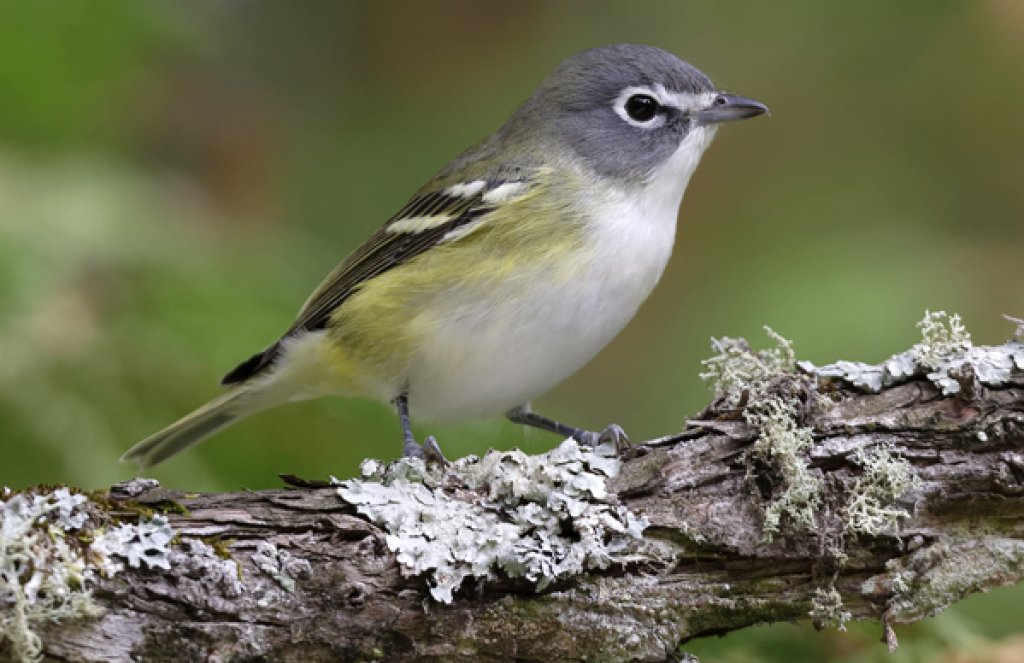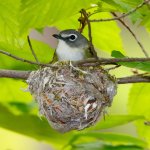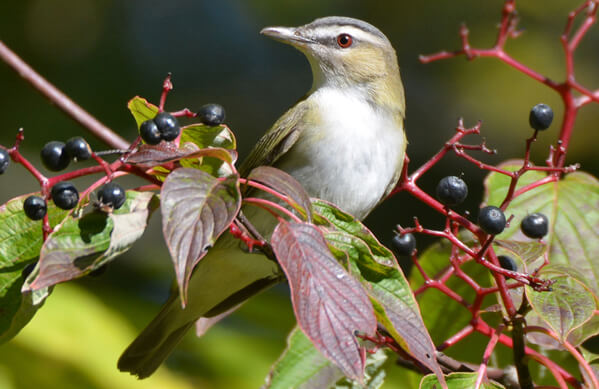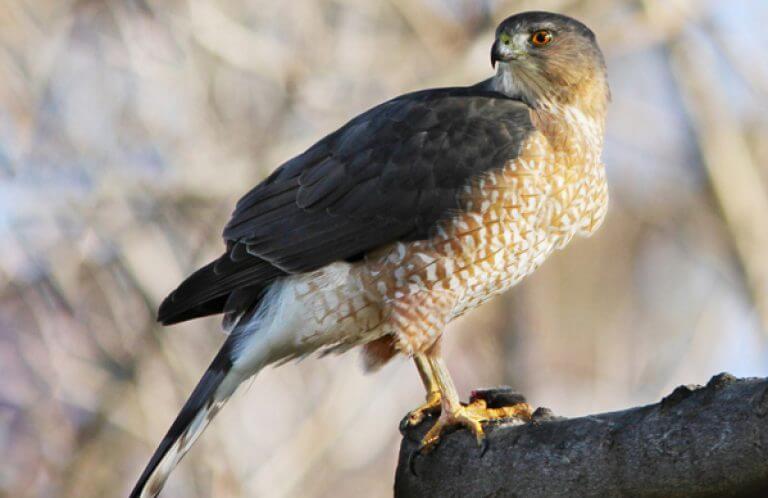About the Blue-headed Vireo
The colorful Blue-headed Vireo is a standout among more plain-plumaged relatives such as the Red-eyed Vireo. This handsome Neotropical migrant is easy to identify, with a blue-gray head set off by bold white "spectacles," bright yellow flanks, olive-green back, and white wingbars. Both sexes are very similar in appearance.
The Blue-headed Vireo's Latin species name solitarius echoes this bird's former common name — the Solitary Vireo — which was used until 1997.
Three from One
John James Audubon first described the Solitary Vireo in 1840 in his seminal book The Birds of America. He noted this bird's wide distribution across North America, but assumed that it was a single species — a belief that persisted to the end of the 20th century.
The increased sophistication of genetic testing, however, eventually led ornithologists to split the Solitary Vireo into three separate species: the Blue-headed, Cassin's, and Plumbeous Vireos. So, what was once the "Solitary" Vireo is now a “cryptic species complex” — a closely related group of animals very similar in appearance, but genetically distinct and physically separate. In this vireo grouping, the Blue-headed Vireo is the most colorful and the one that occurs the farthest to the east.
Songs and Sounds
Typical of the vireo family, the Blue-headed Vireo is described as a “slow but persistent singer.” Its simple song has a particularly sweet, halting quality.
Listen here:
This vireo's call note is a husky chatter. Listen here:
Breeding and Feeding
Early to Arrive, Late to Leave
The Blue-headed Vireo arrives on its breeding grounds in early spring, often before the trees leaf out, then stays later than do most migratory songbirds, sometimes until mid-October.
In spring, the male reaches the breeding grounds first, establishing a rather large territory of up to 15 acres. He begins to build “demo nests” in different parts of his territory, in hopes of attracting a mate. (Females tend to favor males with the biggest and best territories.) This monogamous songbird is notably cooperative, with both male and female sharing nest-building, incubation, and chick-care duties. In fact, male Blue-headed Vireos have been shown to build nests and incubate eggs as much or more than do their mates.
Once a female Blue-headed Vireo accepts a territory and a mate, she begins nest-building in earnest, assisted by the male. The nest, a hanging cup of twigs, grass, and bark, is suspended from a forked branch, usually at mid- to low level in the forest understory. The female lays three to five eggs, which both parents take turns incubating for about two weeks.
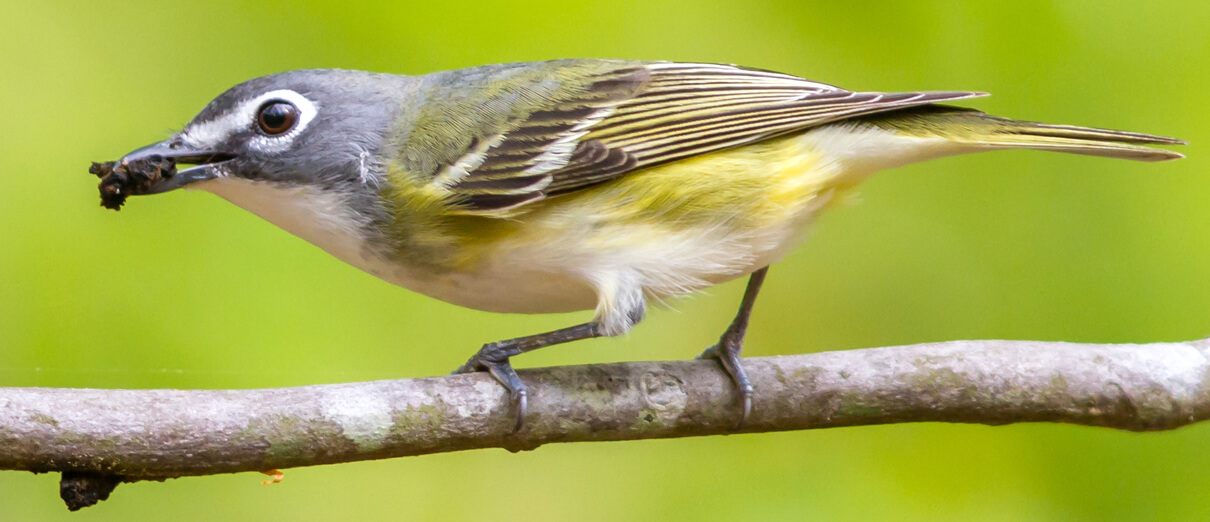
Like the Black-capped Vireo, this species commonly falls host to the Brown-headed Cowbird, females of which “dump” their eggs in the nests of other songbird species. Blue-headed Vireo parents will often build a layer of nesting material atop cowbird eggs if none of their own eggs remain, then lay a new clutch, or they will abandon the nest and eggs and start over. In addition to the threat of cowbird nest parasitism, Blue-headed Vireo eggs and young are often predated by owls, crows, and jays. In response, this vireo may produce multiple broods per season. The canny vireo may also nest close to the nests of large raptors such as the Cooper's Hawk or Red-tailed Hawk, thereby discouraging its more regular nest predators.
Blue-headed Vireo chicks fledge in about two weeks, but remain under a parent's care for at least a week or two longer before they go off on their own. A female vireo may leave her brood to the male's care while she goes off to begin another clutch.
Like other Neotropical migrants such as the American Redstart and Yellow Warbler, the Blue-headed Vireo is an insect-eater throughout the year, feeding on caterpillars, moths and butterflies, stinkbugs, and beetles. It sometimes adds fruits to its diet during the winter. This bird feeds in a slow, methodical fashion, gleaning along twigs and foliage with its stout, slightly hooked bill. It sometimes catches insects on the wing in the manner of an Eastern Phoebe or other flycatcher.
Region and Range
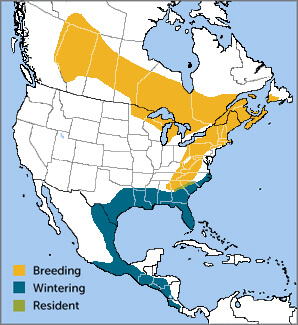
The Blue-headed Vireo favors coniferous forests with a deciduous understory, although it will also breed in deciduous forests. It nests across southern Canada from the Prairie Provinces to Newfoundland, then down the New England Atlantic Coast, and throughout the Appalachians. It is a short-distance migrant, wintering from the southeastern United States to Central America. The Blue-headed and White-eyed Vireos are the only two eastern vireo species that have part of their winter range in the U.S.
Conservation
Although the Blue-headed Vireo remains common, it must contend with the same threats facing scarce forest birds such as the Cerulean Warbler. Because the Blue-headed Vireo prefers to nest in extensive forests, it can be impacted by habitat loss due to clearing and fragmentation. Its habitat is further reduced by acid rain, which kills conifers, and the Hemlock Woolly Adelgid, an introduced insect that has decimated hemlock trees. Collisions with glass and towers may kill these vireos along their migratory pathways.

Help support ABC's conservation mission!
ABC provides a number of resources to help reduce these threats. We are involved in a number of large-scale conservation initiatives to protect and recover habitat on breeding and wintering grounds, including BirdScapes, Migratory Bird Joint Ventures, and Southern Wings. Our collisions program helps to prevent communications tower collisions and fatalities, and provides solutions to prevent bird collisions with glass, particularly at home windows.
Get Involved
Policies enacted by the U.S. Congress and federal agencies, such as the U.S. Fish and Wildlife Service, have a huge impact on migratory birds. You can help shape these rules for the better by urging lawmakers to prioritize birds, bird habitat, and bird-friendly measures. To get started, visit ABC's Action Center.
Living a bird-friendly life can have an immediate impact on migratory birds in the United States. Doing so can be as easy as adding native plants to your garden, avoiding pesticides, and keeping cats indoors. To learn more, visit our Bird-Friendly Life page.
American Bird Conservancy and our Migratory Bird Joint Venture partners have improved conservation management on more than 6.4 million acres of U.S. bird habitat — an area larger than the state of Maryland — over the last ten years. That's not all: With the help of international partners, we've established a network of more than 100 areas of priority bird habitat across the Americas, helping to ensure that birds' needs are met during all stages of their life-cycles. These are monumental undertakings, requiring the support of many, and you can help by making a gift today.





































